TLAW 303 - Taxation Law: Income Tax Application & Calculation
VerifiedAdded on 2023/06/12
|8
|1837
|204
Homework Assignment
AI Summary
This assignment provides detailed solutions to several taxation law problems in the Australian context. It covers income tax calculations for both residents and non-residents, considering different income brackets and company tax rates. The assignment also addresses medical levy and medical levy surcharge calculations, taking into account factors such as private health insurance and family status. Furthermore, it includes calculations for taxable income, PAYG, and tax on dividends. The document is helpful for students studying Australian taxation law and looking for examples of tax calculations. Desklib offers more resources like this, including past papers and solved assignments.
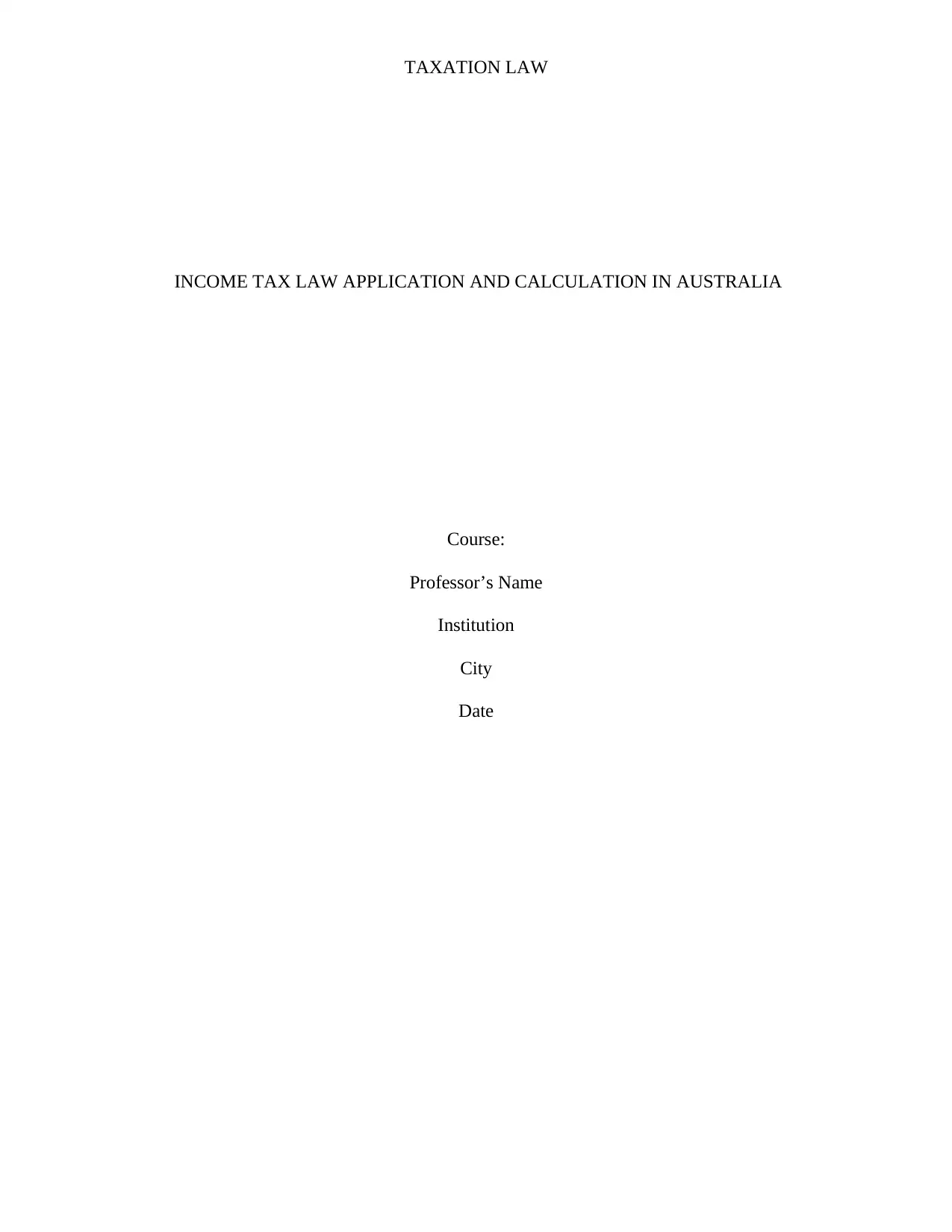
TAXATION LAW
INCOME TAX LAW APPLICATION AND CALCULATION IN AUSTRALIA
Course:
Professor’s Name
Institution
City
Date
INCOME TAX LAW APPLICATION AND CALCULATION IN AUSTRALIA
Course:
Professor’s Name
Institution
City
Date
Paraphrase This Document
Need a fresh take? Get an instant paraphrase of this document with our AI Paraphraser
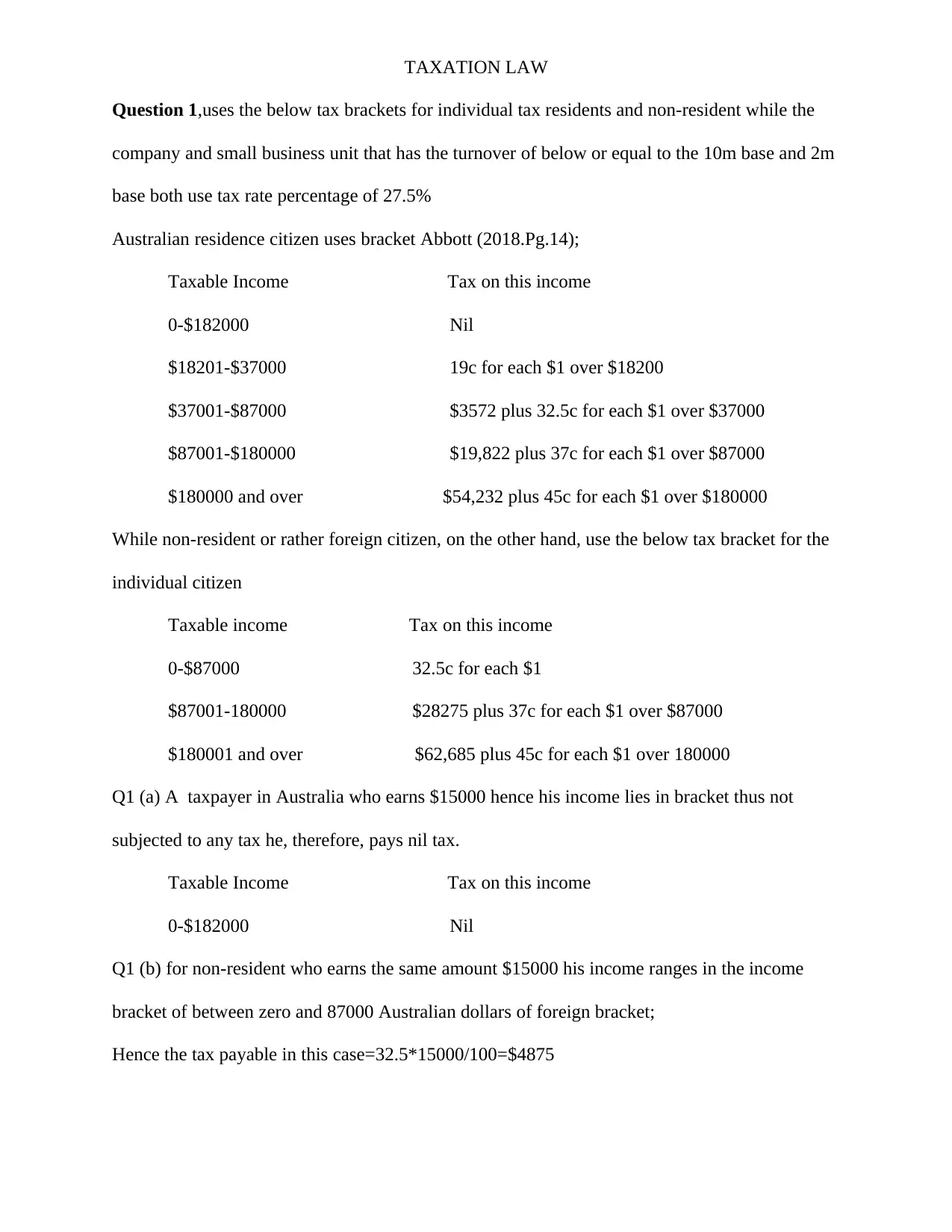
TAXATION LAW
Question 1,uses the below tax brackets for individual tax residents and non-resident while the
company and small business unit that has the turnover of below or equal to the 10m base and 2m
base both use tax rate percentage of 27.5%
Australian residence citizen uses bracket Abbott (2018.Pg.14);
Taxable Income Tax on this income
0-$182000 Nil
$18201-$37000 19c for each $1 over $18200
$37001-$87000 $3572 plus 32.5c for each $1 over $37000
$87001-$180000 $19,822 plus 37c for each $1 over $87000
$180000 and over $54,232 plus 45c for each $1 over $180000
While non-resident or rather foreign citizen, on the other hand, use the below tax bracket for the
individual citizen
Taxable income Tax on this income
0-$87000 32.5c for each $1
$87001-180000 $28275 plus 37c for each $1 over $87000
$180001 and over $62,685 plus 45c for each $1 over 180000
Q1 (a) A taxpayer in Australia who earns $15000 hence his income lies in bracket thus not
subjected to any tax he, therefore, pays nil tax.
Taxable Income Tax on this income
0-$182000 Nil
Q1 (b) for non-resident who earns the same amount $15000 his income ranges in the income
bracket of between zero and 87000 Australian dollars of foreign bracket;
Hence the tax payable in this case=32.5*15000/100=$4875
Question 1,uses the below tax brackets for individual tax residents and non-resident while the
company and small business unit that has the turnover of below or equal to the 10m base and 2m
base both use tax rate percentage of 27.5%
Australian residence citizen uses bracket Abbott (2018.Pg.14);
Taxable Income Tax on this income
0-$182000 Nil
$18201-$37000 19c for each $1 over $18200
$37001-$87000 $3572 plus 32.5c for each $1 over $37000
$87001-$180000 $19,822 plus 37c for each $1 over $87000
$180000 and over $54,232 plus 45c for each $1 over $180000
While non-resident or rather foreign citizen, on the other hand, use the below tax bracket for the
individual citizen
Taxable income Tax on this income
0-$87000 32.5c for each $1
$87001-180000 $28275 plus 37c for each $1 over $87000
$180001 and over $62,685 plus 45c for each $1 over 180000
Q1 (a) A taxpayer in Australia who earns $15000 hence his income lies in bracket thus not
subjected to any tax he, therefore, pays nil tax.
Taxable Income Tax on this income
0-$182000 Nil
Q1 (b) for non-resident who earns the same amount $15000 his income ranges in the income
bracket of between zero and 87000 Australian dollars of foreign bracket;
Hence the tax payable in this case=32.5*15000/100=$4875
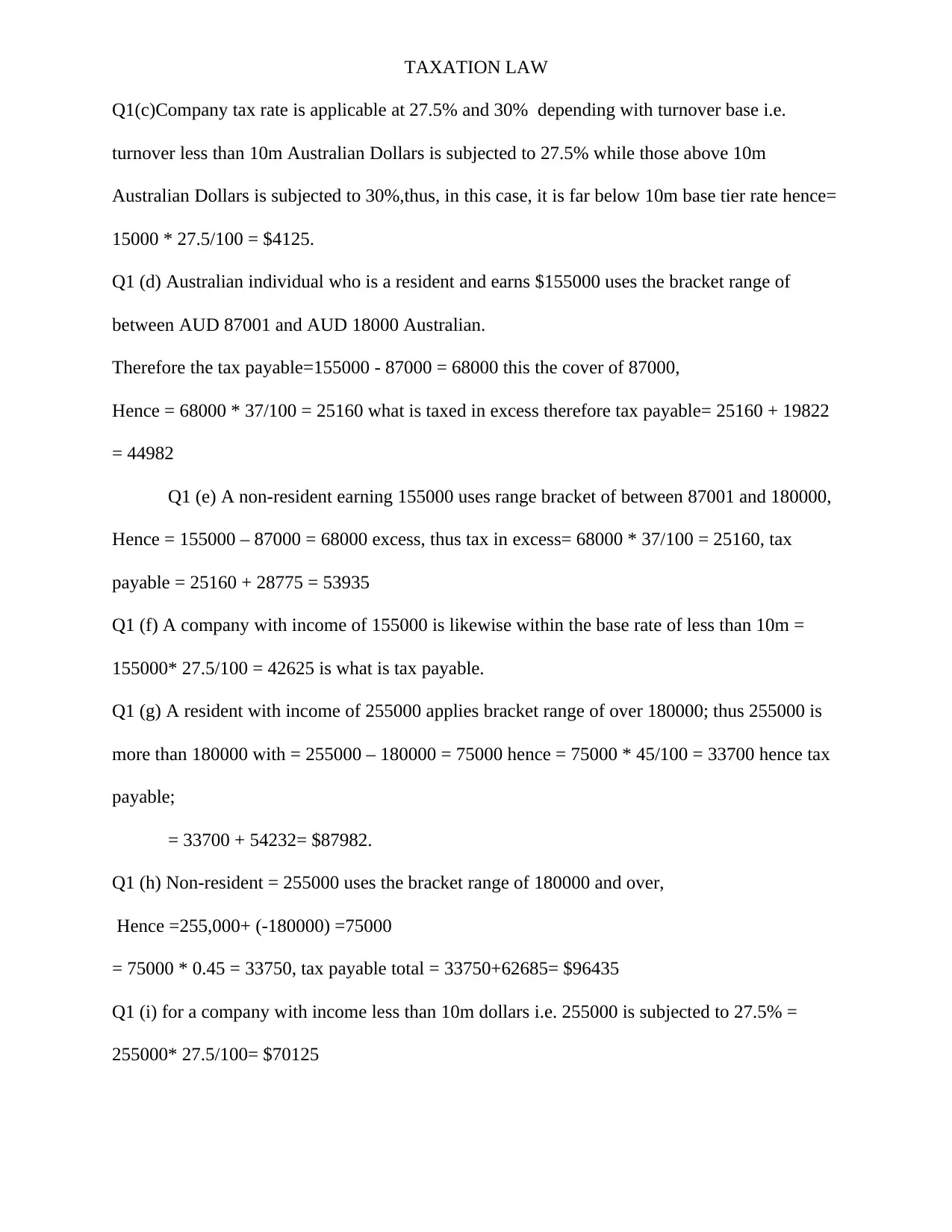
TAXATION LAW
Q1(c)Company tax rate is applicable at 27.5% and 30% depending with turnover base i.e.
turnover less than 10m Australian Dollars is subjected to 27.5% while those above 10m
Australian Dollars is subjected to 30%,thus, in this case, it is far below 10m base tier rate hence=
15000 * 27.5/100 = $4125.
Q1 (d) Australian individual who is a resident and earns $155000 uses the bracket range of
between AUD 87001 and AUD 18000 Australian.
Therefore the tax payable=155000 - 87000 = 68000 this the cover of 87000,
Hence = 68000 * 37/100 = 25160 what is taxed in excess therefore tax payable= 25160 + 19822
= 44982
Q1 (e) A non-resident earning 155000 uses range bracket of between 87001 and 180000,
Hence = 155000 – 87000 = 68000 excess, thus tax in excess= 68000 * 37/100 = 25160, tax
payable = 25160 + 28775 = 53935
Q1 (f) A company with income of 155000 is likewise within the base rate of less than 10m =
155000* 27.5/100 = 42625 is what is tax payable.
Q1 (g) A resident with income of 255000 applies bracket range of over 180000; thus 255000 is
more than 180000 with = 255000 – 180000 = 75000 hence = 75000 * 45/100 = 33700 hence tax
payable;
= 33700 + 54232= $87982.
Q1 (h) Non-resident = 255000 uses the bracket range of 180000 and over,
Hence =255,000+ (-180000) =75000
= 75000 * 0.45 = 33750, tax payable total = 33750+62685= $96435
Q1 (i) for a company with income less than 10m dollars i.e. 255000 is subjected to 27.5% =
255000* 27.5/100= $70125
Q1(c)Company tax rate is applicable at 27.5% and 30% depending with turnover base i.e.
turnover less than 10m Australian Dollars is subjected to 27.5% while those above 10m
Australian Dollars is subjected to 30%,thus, in this case, it is far below 10m base tier rate hence=
15000 * 27.5/100 = $4125.
Q1 (d) Australian individual who is a resident and earns $155000 uses the bracket range of
between AUD 87001 and AUD 18000 Australian.
Therefore the tax payable=155000 - 87000 = 68000 this the cover of 87000,
Hence = 68000 * 37/100 = 25160 what is taxed in excess therefore tax payable= 25160 + 19822
= 44982
Q1 (e) A non-resident earning 155000 uses range bracket of between 87001 and 180000,
Hence = 155000 – 87000 = 68000 excess, thus tax in excess= 68000 * 37/100 = 25160, tax
payable = 25160 + 28775 = 53935
Q1 (f) A company with income of 155000 is likewise within the base rate of less than 10m =
155000* 27.5/100 = 42625 is what is tax payable.
Q1 (g) A resident with income of 255000 applies bracket range of over 180000; thus 255000 is
more than 180000 with = 255000 – 180000 = 75000 hence = 75000 * 45/100 = 33700 hence tax
payable;
= 33700 + 54232= $87982.
Q1 (h) Non-resident = 255000 uses the bracket range of 180000 and over,
Hence =255,000+ (-180000) =75000
= 75000 * 0.45 = 33750, tax payable total = 33750+62685= $96435
Q1 (i) for a company with income less than 10m dollars i.e. 255000 is subjected to 27.5% =
255000* 27.5/100= $70125
⊘ This is a preview!⊘
Do you want full access?
Subscribe today to unlock all pages.

Trusted by 1+ million students worldwide
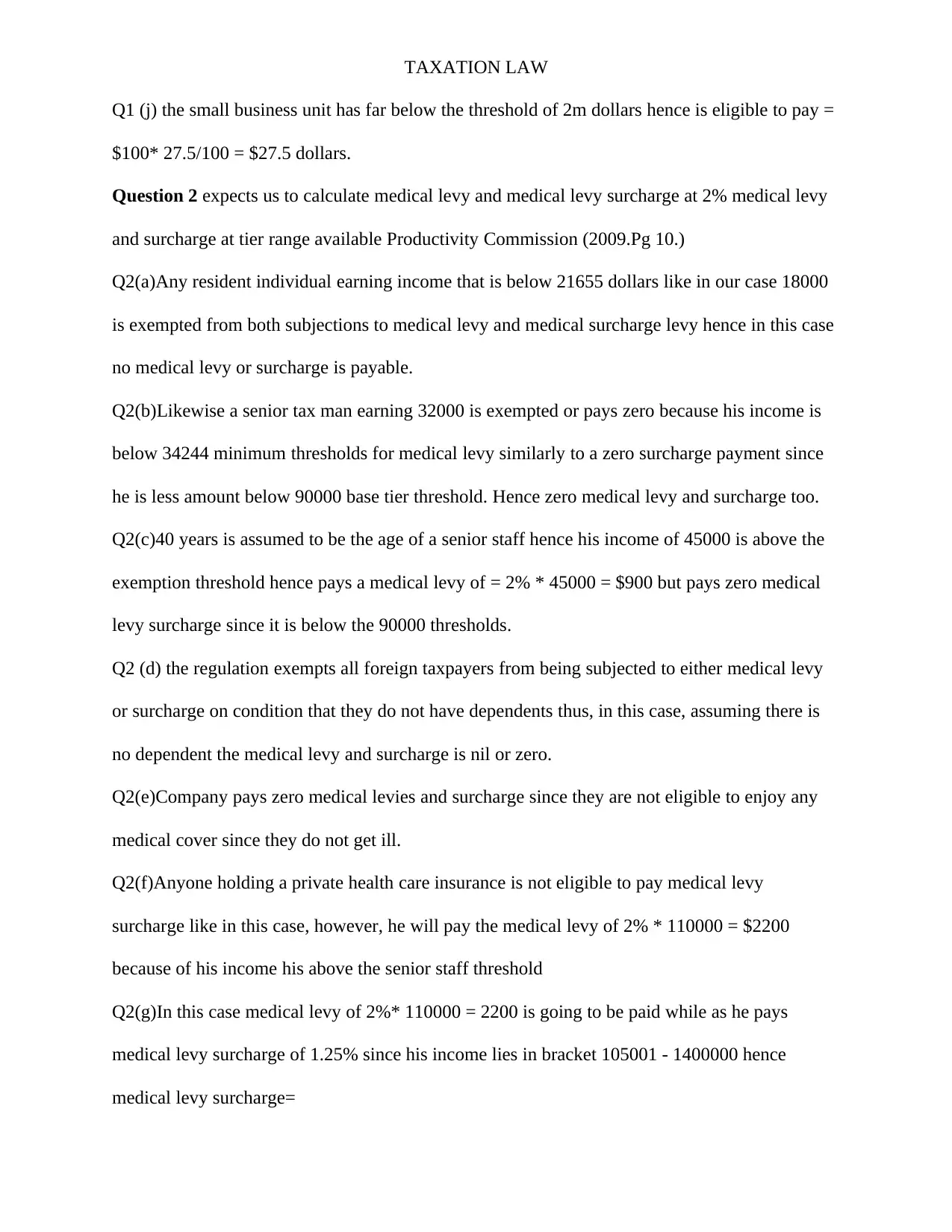
TAXATION LAW
Q1 (j) the small business unit has far below the threshold of 2m dollars hence is eligible to pay =
$100* 27.5/100 = $27.5 dollars.
Question 2 expects us to calculate medical levy and medical levy surcharge at 2% medical levy
and surcharge at tier range available Productivity Commission (2009.Pg 10.)
Q2(a)Any resident individual earning income that is below 21655 dollars like in our case 18000
is exempted from both subjections to medical levy and medical surcharge levy hence in this case
no medical levy or surcharge is payable.
Q2(b)Likewise a senior tax man earning 32000 is exempted or pays zero because his income is
below 34244 minimum thresholds for medical levy similarly to a zero surcharge payment since
he is less amount below 90000 base tier threshold. Hence zero medical levy and surcharge too.
Q2(c)40 years is assumed to be the age of a senior staff hence his income of 45000 is above the
exemption threshold hence pays a medical levy of = 2% * 45000 = $900 but pays zero medical
levy surcharge since it is below the 90000 thresholds.
Q2 (d) the regulation exempts all foreign taxpayers from being subjected to either medical levy
or surcharge on condition that they do not have dependents thus, in this case, assuming there is
no dependent the medical levy and surcharge is nil or zero.
Q2(e)Company pays zero medical levies and surcharge since they are not eligible to enjoy any
medical cover since they do not get ill.
Q2(f)Anyone holding a private health care insurance is not eligible to pay medical levy
surcharge like in this case, however, he will pay the medical levy of 2% * 110000 = $2200
because of his income his above the senior staff threshold
Q2(g)In this case medical levy of 2%* 110000 = 2200 is going to be paid while as he pays
medical levy surcharge of 1.25% since his income lies in bracket 105001 - 1400000 hence
medical levy surcharge=
Q1 (j) the small business unit has far below the threshold of 2m dollars hence is eligible to pay =
$100* 27.5/100 = $27.5 dollars.
Question 2 expects us to calculate medical levy and medical levy surcharge at 2% medical levy
and surcharge at tier range available Productivity Commission (2009.Pg 10.)
Q2(a)Any resident individual earning income that is below 21655 dollars like in our case 18000
is exempted from both subjections to medical levy and medical surcharge levy hence in this case
no medical levy or surcharge is payable.
Q2(b)Likewise a senior tax man earning 32000 is exempted or pays zero because his income is
below 34244 minimum thresholds for medical levy similarly to a zero surcharge payment since
he is less amount below 90000 base tier threshold. Hence zero medical levy and surcharge too.
Q2(c)40 years is assumed to be the age of a senior staff hence his income of 45000 is above the
exemption threshold hence pays a medical levy of = 2% * 45000 = $900 but pays zero medical
levy surcharge since it is below the 90000 thresholds.
Q2 (d) the regulation exempts all foreign taxpayers from being subjected to either medical levy
or surcharge on condition that they do not have dependents thus, in this case, assuming there is
no dependent the medical levy and surcharge is nil or zero.
Q2(e)Company pays zero medical levies and surcharge since they are not eligible to enjoy any
medical cover since they do not get ill.
Q2(f)Anyone holding a private health care insurance is not eligible to pay medical levy
surcharge like in this case, however, he will pay the medical levy of 2% * 110000 = $2200
because of his income his above the senior staff threshold
Q2(g)In this case medical levy of 2%* 110000 = 2200 is going to be paid while as he pays
medical levy surcharge of 1.25% since his income lies in bracket 105001 - 1400000 hence
medical levy surcharge=
Paraphrase This Document
Need a fresh take? Get an instant paraphrase of this document with our AI Paraphraser
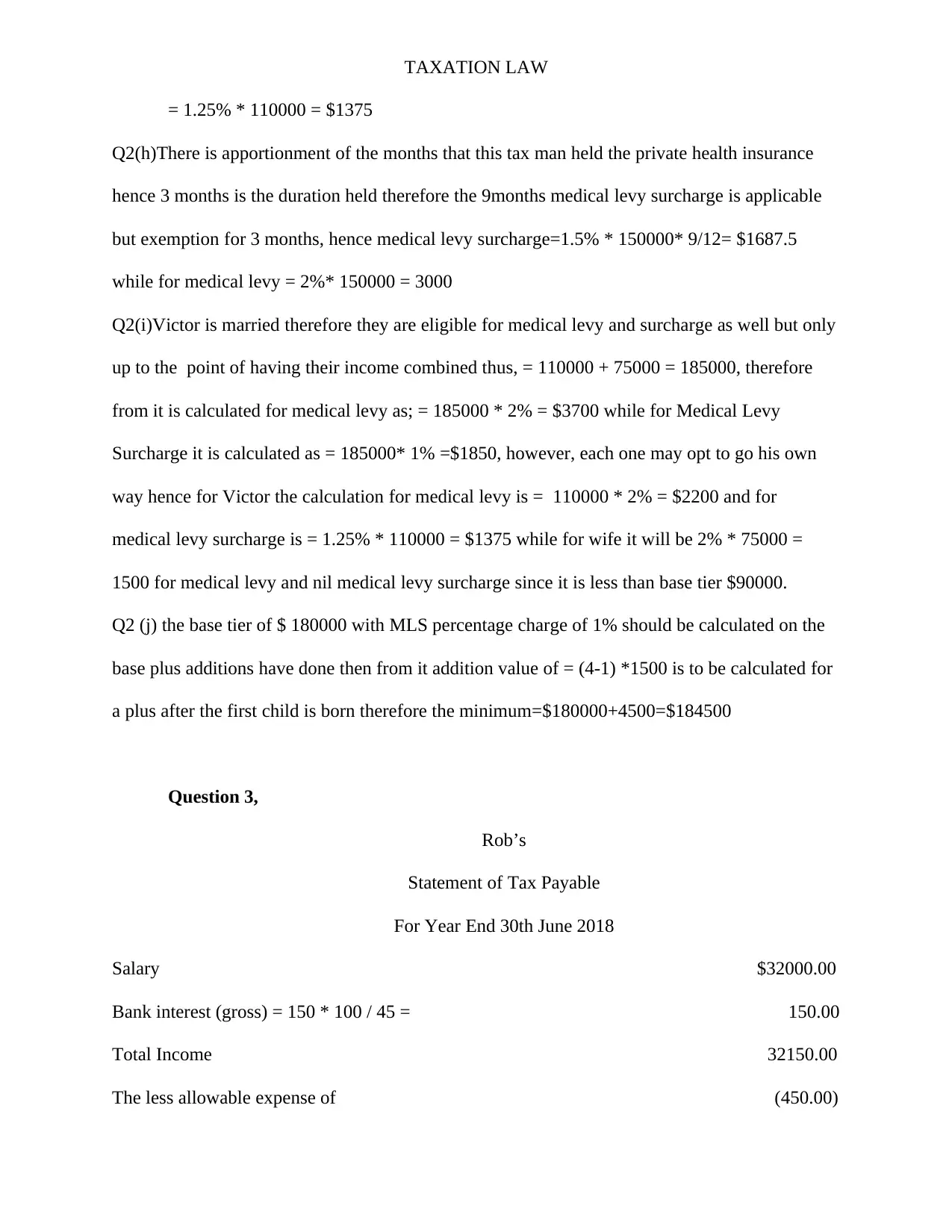
TAXATION LAW
= 1.25% * 110000 = $1375
Q2(h)There is apportionment of the months that this tax man held the private health insurance
hence 3 months is the duration held therefore the 9months medical levy surcharge is applicable
but exemption for 3 months, hence medical levy surcharge=1.5% * 150000* 9/12= $1687.5
while for medical levy = 2%* 150000 = 3000
Q2(i)Victor is married therefore they are eligible for medical levy and surcharge as well but only
up to the point of having their income combined thus, = 110000 + 75000 = 185000, therefore
from it is calculated for medical levy as; = 185000 * 2% = $3700 while for Medical Levy
Surcharge it is calculated as = 185000* 1% =$1850, however, each one may opt to go his own
way hence for Victor the calculation for medical levy is = 110000 * 2% = $2200 and for
medical levy surcharge is = 1.25% * 110000 = $1375 while for wife it will be 2% * 75000 =
1500 for medical levy and nil medical levy surcharge since it is less than base tier $90000.
Q2 (j) the base tier of $ 180000 with MLS percentage charge of 1% should be calculated on the
base plus additions have done then from it addition value of = (4-1) *1500 is to be calculated for
a plus after the first child is born therefore the minimum=$180000+4500=$184500
Question 3,
Rob’s
Statement of Tax Payable
For Year End 30th June 2018
Salary $32000.00
Bank interest (gross) = 150 * 100 / 45 = 150.00
Total Income 32150.00
The less allowable expense of (450.00)
= 1.25% * 110000 = $1375
Q2(h)There is apportionment of the months that this tax man held the private health insurance
hence 3 months is the duration held therefore the 9months medical levy surcharge is applicable
but exemption for 3 months, hence medical levy surcharge=1.5% * 150000* 9/12= $1687.5
while for medical levy = 2%* 150000 = 3000
Q2(i)Victor is married therefore they are eligible for medical levy and surcharge as well but only
up to the point of having their income combined thus, = 110000 + 75000 = 185000, therefore
from it is calculated for medical levy as; = 185000 * 2% = $3700 while for Medical Levy
Surcharge it is calculated as = 185000* 1% =$1850, however, each one may opt to go his own
way hence for Victor the calculation for medical levy is = 110000 * 2% = $2200 and for
medical levy surcharge is = 1.25% * 110000 = $1375 while for wife it will be 2% * 75000 =
1500 for medical levy and nil medical levy surcharge since it is less than base tier $90000.
Q2 (j) the base tier of $ 180000 with MLS percentage charge of 1% should be calculated on the
base plus additions have done then from it addition value of = (4-1) *1500 is to be calculated for
a plus after the first child is born therefore the minimum=$180000+4500=$184500
Question 3,
Rob’s
Statement of Tax Payable
For Year End 30th June 2018
Salary $32000.00
Bank interest (gross) = 150 * 100 / 45 = 150.00
Total Income 32150.00
The less allowable expense of (450.00)
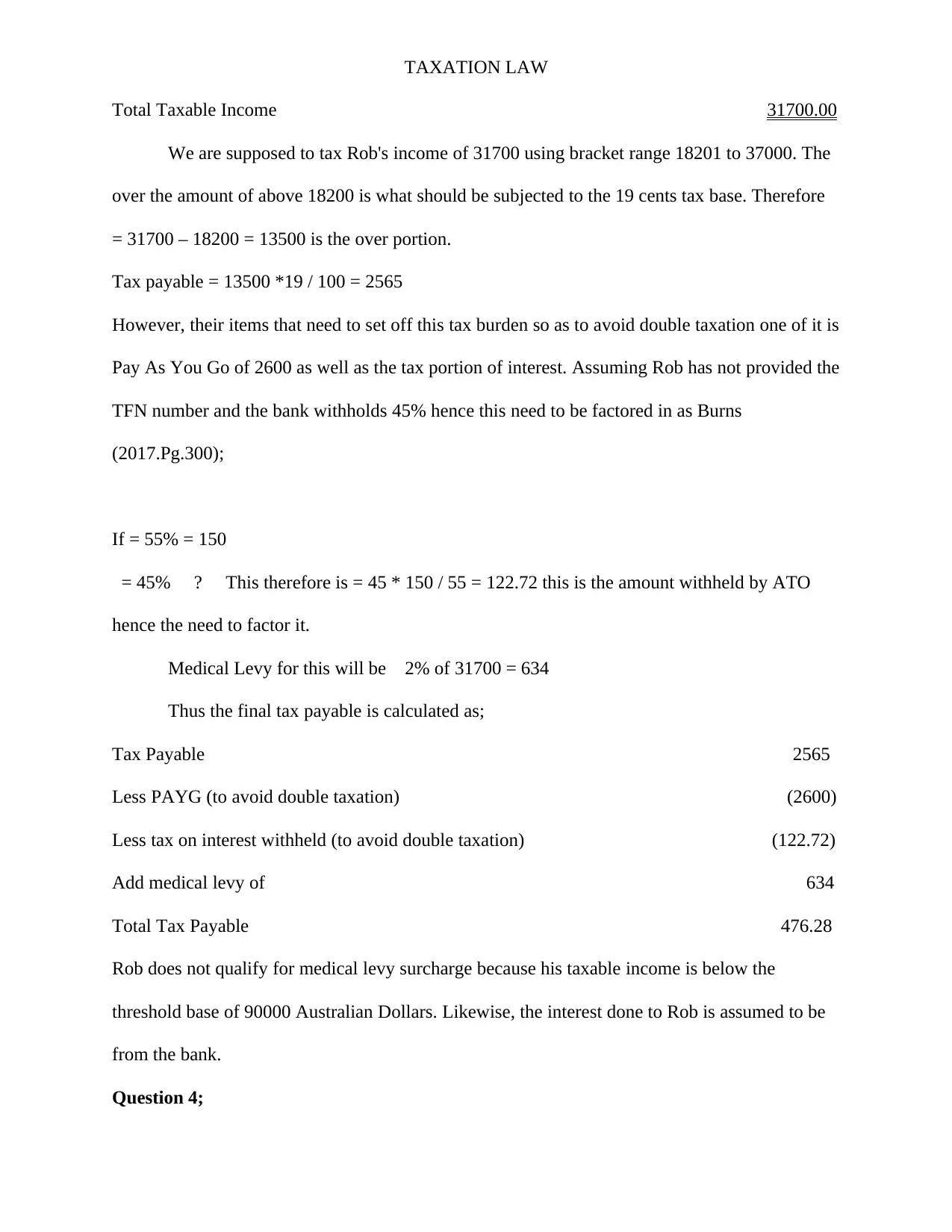
TAXATION LAW
Total Taxable Income 31700.00
We are supposed to tax Rob's income of 31700 using bracket range 18201 to 37000. The
over the amount of above 18200 is what should be subjected to the 19 cents tax base. Therefore
= 31700 – 18200 = 13500 is the over portion.
Tax payable = 13500 *19 / 100 = 2565
However, their items that need to set off this tax burden so as to avoid double taxation one of it is
Pay As You Go of 2600 as well as the tax portion of interest. Assuming Rob has not provided the
TFN number and the bank withholds 45% hence this need to be factored in as Burns
(2017.Pg.300);
If = 55% = 150
= 45% ? This therefore is = 45 * 150 / 55 = 122.72 this is the amount withheld by ATO
hence the need to factor it.
Medical Levy for this will be 2% of 31700 = 634
Thus the final tax payable is calculated as;
Tax Payable 2565
Less PAYG (to avoid double taxation) (2600)
Less tax on interest withheld (to avoid double taxation) (122.72)
Add medical levy of 634
Total Tax Payable 476.28
Rob does not qualify for medical levy surcharge because his taxable income is below the
threshold base of 90000 Australian Dollars. Likewise, the interest done to Rob is assumed to be
from the bank.
Question 4;
Total Taxable Income 31700.00
We are supposed to tax Rob's income of 31700 using bracket range 18201 to 37000. The
over the amount of above 18200 is what should be subjected to the 19 cents tax base. Therefore
= 31700 – 18200 = 13500 is the over portion.
Tax payable = 13500 *19 / 100 = 2565
However, their items that need to set off this tax burden so as to avoid double taxation one of it is
Pay As You Go of 2600 as well as the tax portion of interest. Assuming Rob has not provided the
TFN number and the bank withholds 45% hence this need to be factored in as Burns
(2017.Pg.300);
If = 55% = 150
= 45% ? This therefore is = 45 * 150 / 55 = 122.72 this is the amount withheld by ATO
hence the need to factor it.
Medical Levy for this will be 2% of 31700 = 634
Thus the final tax payable is calculated as;
Tax Payable 2565
Less PAYG (to avoid double taxation) (2600)
Less tax on interest withheld (to avoid double taxation) (122.72)
Add medical levy of 634
Total Tax Payable 476.28
Rob does not qualify for medical levy surcharge because his taxable income is below the
threshold base of 90000 Australian Dollars. Likewise, the interest done to Rob is assumed to be
from the bank.
Question 4;
⊘ This is a preview!⊘
Do you want full access?
Subscribe today to unlock all pages.

Trusted by 1+ million students worldwide
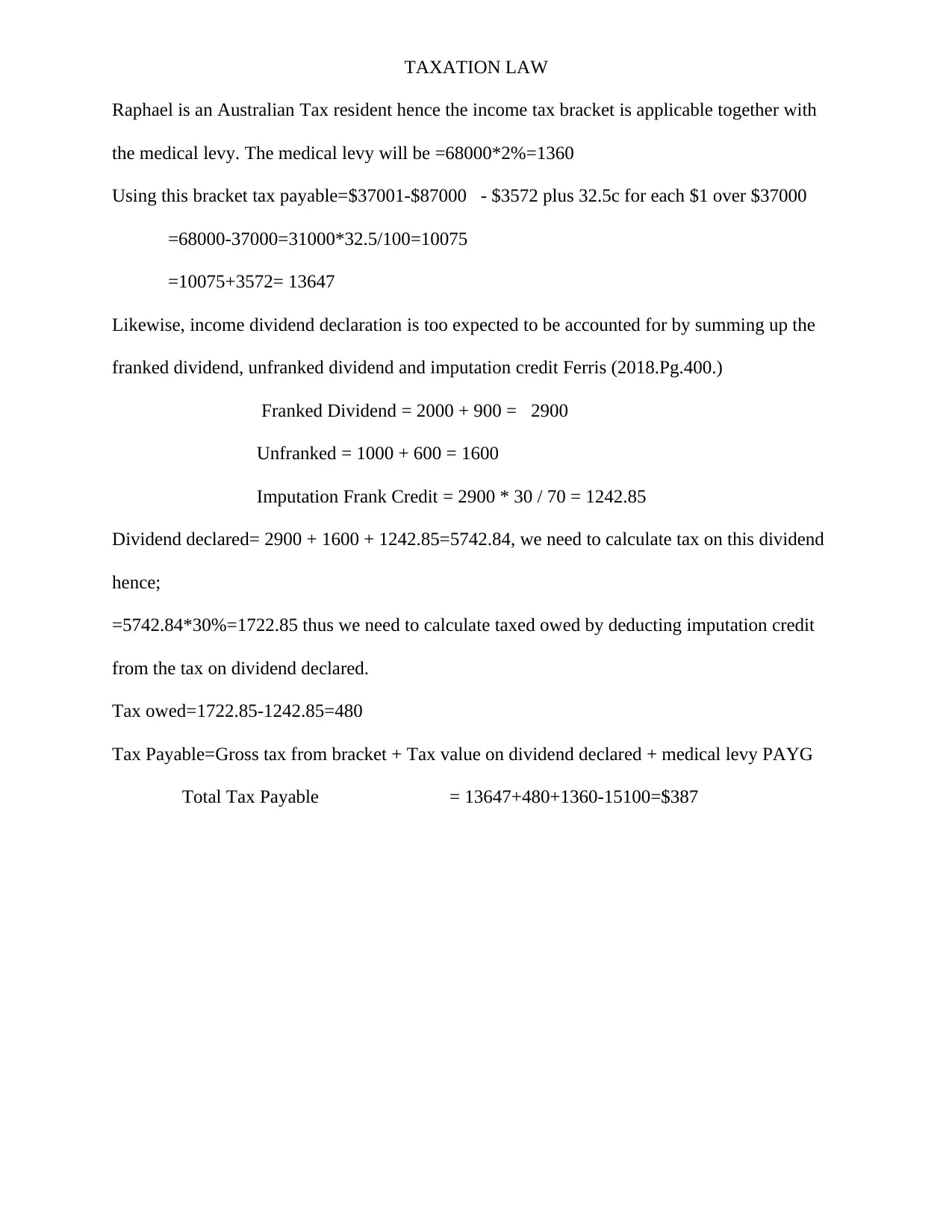
TAXATION LAW
Raphael is an Australian Tax resident hence the income tax bracket is applicable together with
the medical levy. The medical levy will be =68000*2%=1360
Using this bracket tax payable=$37001-$87000 - $3572 plus 32.5c for each $1 over $37000
=68000-37000=31000*32.5/100=10075
=10075+3572= 13647
Likewise, income dividend declaration is too expected to be accounted for by summing up the
franked dividend, unfranked dividend and imputation credit Ferris (2018.Pg.400.)
Franked Dividend = 2000 + 900 = 2900
Unfranked = 1000 + 600 = 1600
Imputation Frank Credit = 2900 * 30 / 70 = 1242.85
Dividend declared= 2900 + 1600 + 1242.85=5742.84, we need to calculate tax on this dividend
hence;
=5742.84*30%=1722.85 thus we need to calculate taxed owed by deducting imputation credit
from the tax on dividend declared.
Tax owed=1722.85-1242.85=480
Tax Payable=Gross tax from bracket + Tax value on dividend declared + medical levy PAYG
Total Tax Payable = 13647+480+1360-15100=$387
Raphael is an Australian Tax resident hence the income tax bracket is applicable together with
the medical levy. The medical levy will be =68000*2%=1360
Using this bracket tax payable=$37001-$87000 - $3572 plus 32.5c for each $1 over $37000
=68000-37000=31000*32.5/100=10075
=10075+3572= 13647
Likewise, income dividend declaration is too expected to be accounted for by summing up the
franked dividend, unfranked dividend and imputation credit Ferris (2018.Pg.400.)
Franked Dividend = 2000 + 900 = 2900
Unfranked = 1000 + 600 = 1600
Imputation Frank Credit = 2900 * 30 / 70 = 1242.85
Dividend declared= 2900 + 1600 + 1242.85=5742.84, we need to calculate tax on this dividend
hence;
=5742.84*30%=1722.85 thus we need to calculate taxed owed by deducting imputation credit
from the tax on dividend declared.
Tax owed=1722.85-1242.85=480
Tax Payable=Gross tax from bracket + Tax value on dividend declared + medical levy PAYG
Total Tax Payable = 13647+480+1360-15100=$387
Paraphrase This Document
Need a fresh take? Get an instant paraphrase of this document with our AI Paraphraser
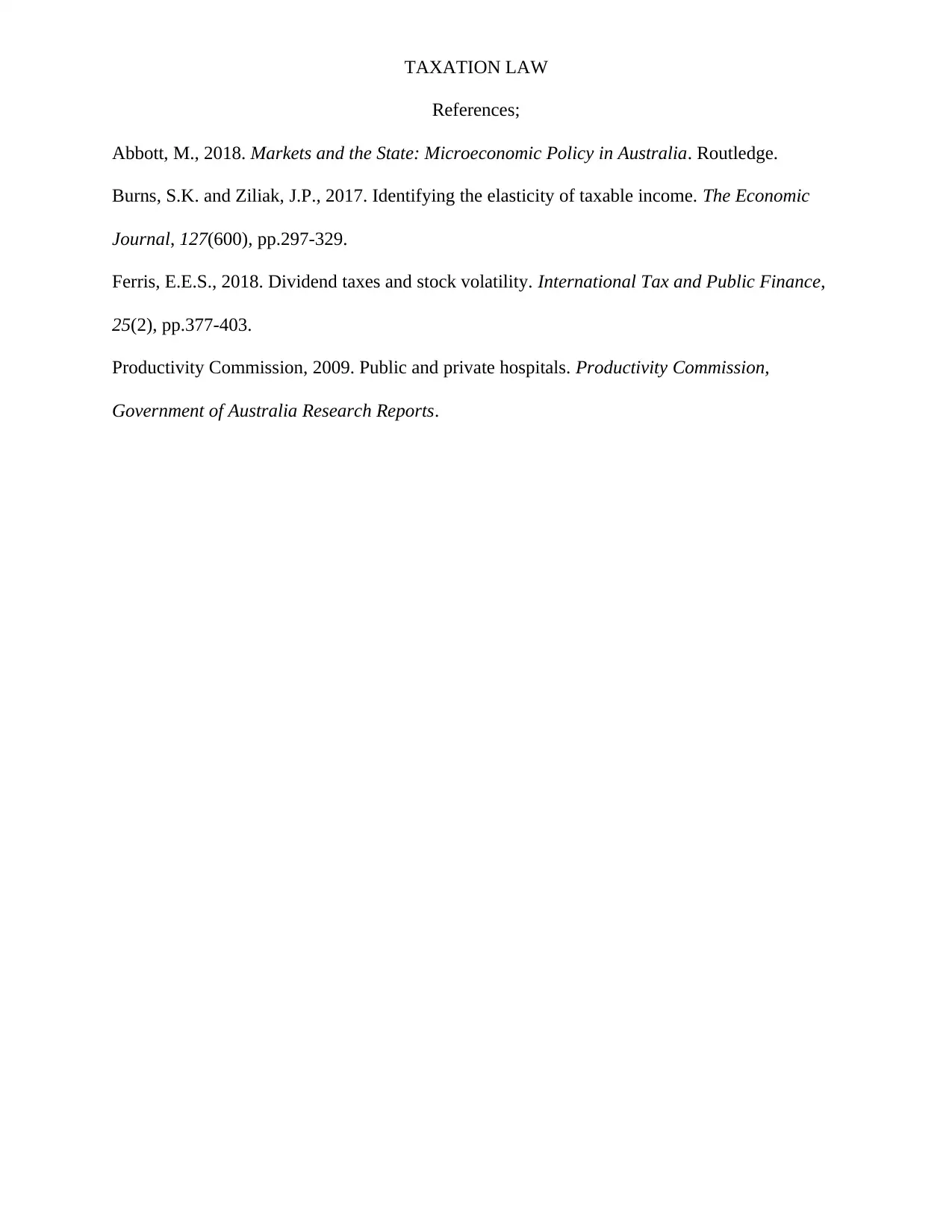
TAXATION LAW
References;
Abbott, M., 2018. Markets and the State: Microeconomic Policy in Australia. Routledge.
Burns, S.K. and Ziliak, J.P., 2017. Identifying the elasticity of taxable income. The Economic
Journal, 127(600), pp.297-329.
Ferris, E.E.S., 2018. Dividend taxes and stock volatility. International Tax and Public Finance,
25(2), pp.377-403.
Productivity Commission, 2009. Public and private hospitals. Productivity Commission,
Government of Australia Research Reports.
References;
Abbott, M., 2018. Markets and the State: Microeconomic Policy in Australia. Routledge.
Burns, S.K. and Ziliak, J.P., 2017. Identifying the elasticity of taxable income. The Economic
Journal, 127(600), pp.297-329.
Ferris, E.E.S., 2018. Dividend taxes and stock volatility. International Tax and Public Finance,
25(2), pp.377-403.
Productivity Commission, 2009. Public and private hospitals. Productivity Commission,
Government of Australia Research Reports.
1 out of 8
Related Documents
Your All-in-One AI-Powered Toolkit for Academic Success.
+13062052269
info@desklib.com
Available 24*7 on WhatsApp / Email
![[object Object]](/_next/static/media/star-bottom.7253800d.svg)
Unlock your academic potential
Copyright © 2020–2025 A2Z Services. All Rights Reserved. Developed and managed by ZUCOL.




